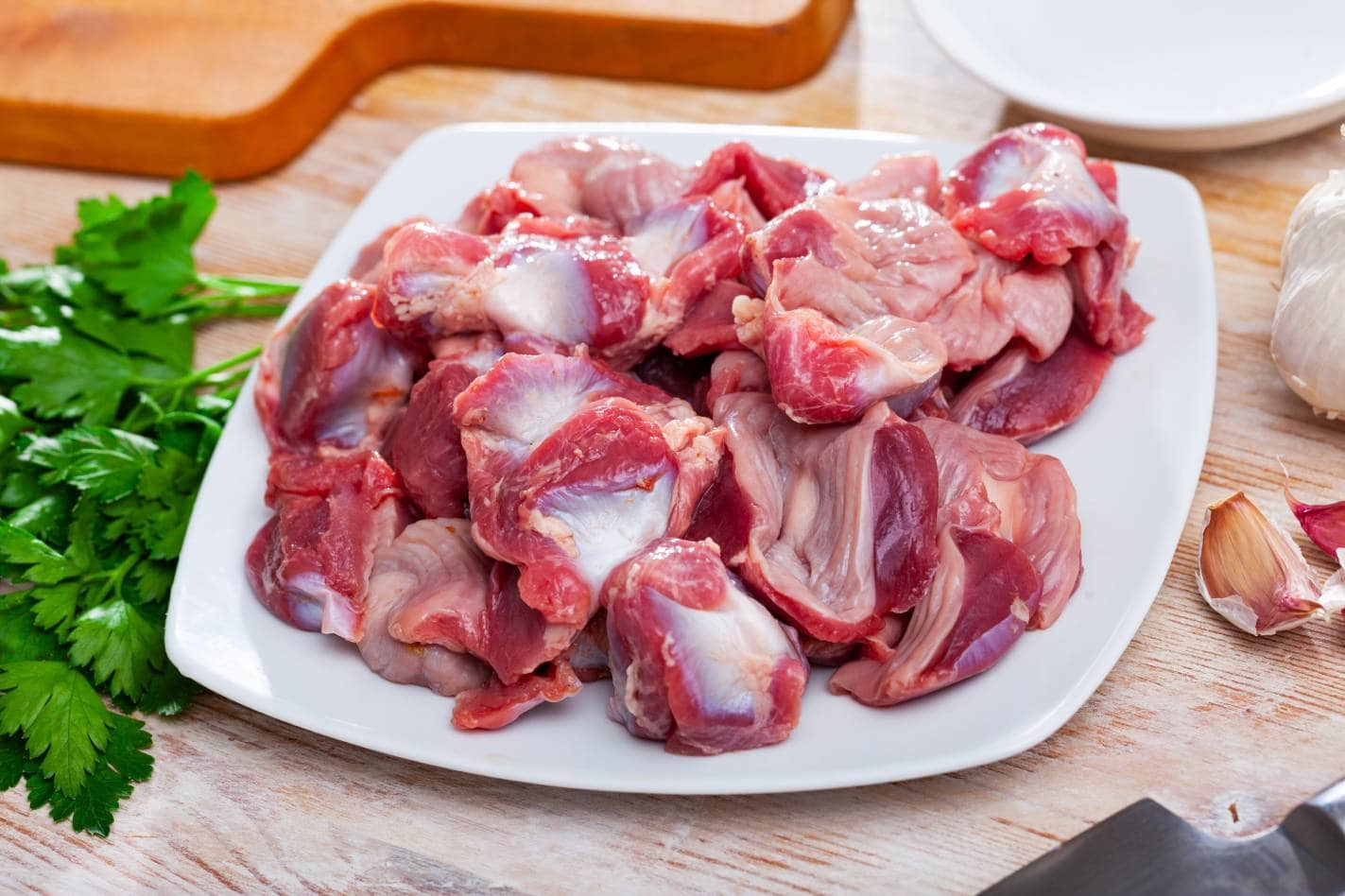Chicken gizzards often get overlooked. Many people might even feel unsure about them. Yet, these unique parts hold a special place in kitchens all over the world. You see them from street food carts to fancy restaurants. A lot of people love them. But what exactly is a chicken gizzard? Is it something you should add to your diet? This article looks at what’s inside gizzards. We will cover their health benefits and how to prepare them. We give you a balanced view. This helps you decide if this organ meat is right for you.
Understanding the Chicken Gizzard
The chicken gizzard is a key part of a bird’s stomach. This strong organ helps grind food. It handles things like seeds and small stones that birds eat. It stands out from other chicken parts. It is tough, with a muscle-like feel and a distinct taste that sets it apart. Learning about its role in a chicken helps explain its special traits.
What is a Chicken Gizzard?
- Explanation of its role in a chicken’s digestive system: Think of the gizzard as a chicken’s “second stomach.” It is a powerful, muscular organ. It helps break down tough foods that the bird swallows whole.
- Physical characteristics and texture: Chicken gizzards have a firm, robust feel. They are pretty tough when raw. This comes from their job of grinding food.
Nutritional Breakdown: What’s Inside?
- High protein content: Chicken gizzards are a rich source of protein. Protein helps build and fix muscles. It also keeps you feeling full. This makes gizzards a good choice for active people.
- Rich in vitamins and minerals: Gizzards are full of good things your body needs.
- Iron: This mineral carries oxygen in your blood. It helps keep your energy levels up. Not enough iron can make you tired.
- Zinc: Zinc helps your body fight off sickness. It also plays a role in how your cells grow.
- B vitamins (especially B12 and niacin): These vitamins are vital for turning food into energy. They also keep your nerves working well.
- Fat content and cholesterol: Gizzards do have some fat and cholesterol. It is good to know this. We will talk more about how this fits into your diet. Most people can enjoy them in a balanced way.
The Pros of Eating Chicken Gizzards
Chicken gizzards offer many nutrients. They can be a great addition to your meals. This is especially true if you want cheap protein. Their special texture and ability to soak up flavors also make them fun to cook with.
Health Benefits
- Excellent source of lean protein:
- Muscle repair and growth: The protein in gizzards supports your body. It helps muscles recover after exercise. It also aids in building new muscle.
- Satiety and weight management: Eating protein helps you feel full longer. This can help you avoid overeating. It might help with managing your weight.
- Boosts iron intake:
- Combating iron deficiency: Many people do not get enough iron. This can lead to feeling weak. Gizzards offer a good way to get more iron.
- Improving energy levels: Enough iron means more energy. Your body can move oxygen better. This helps you feel more active.
- Rich in essential minerals:
- Zinc for immune support: Zinc is a key mineral. It helps your immune system work properly. A strong immune system fights off germs.
- B vitamins for energy metabolism: B vitamins are like fuel for your body. They help change the food you eat into power. This power keeps you going all day.
- Affordable and accessible:
- Cost-effective protein option: Gizzards are often cheaper than other meats. They offer great value for your money. You can get good protein without spending a lot.
- Readily available in most markets: You can find gizzards in many grocery stores. Check the meat section or ask your local butcher.
Culinary Versatility
- Absorbs flavors well: Gizzards soak up marinades and spices beautifully. Their firm texture holds onto tasty sauces. This makes them very flavorful.
- Texture appeal:
- Chewy and satisfying: Many people enjoy the unique chewiness of gizzards. It gives a satisfying mouthfeel. This sets them apart from other meats.
- Versatile cooking methods: You can cook gizzards in many ways.
- Frying: This makes them crispy on the outside. It is a popular way to enjoy them.
- Braising/Stewing: Slow cooking tenderizes them. They become much softer this way.
- Grilling: Grilling adds a smoky taste. It gives them a nice charred skin.
- Global culinary traditions: Gizzards are loved in many cultures.
- Examples from different cuisines: They are big in African cooking. You find them in Asian stir-fries, too. In the American South, fried gizzards are a favorite.
The Cons of Eating Chicken Gizzards
Gizzards offer several health benefits for your body. But there are also a few points to think about. These often relate to how they feel, how you cook them, and how much salt they might have.
Texture and Preparation Challenges
- Toughness if not cooked properly:
- Importance of slow cooking: Gizzards need time to get tender. Long, slow cooking helps break down their tough parts. Think stews or braises.
- Risk of rubbery texture: If you cook them too fast or not long enough, they stay rubbery. They become hard to chew. This is a common mistake.
- Preparation time:
- Trimming and cleaning: Before cooking, you might need to trim them. Some parts are not good to eat. This takes a little extra time.
- Extended cooking times: Getting gizzards soft often means hours of cooking. Braising or stewing can take a while. Plan your meals.
Potential Health Drawbacks
- High cholesterol content:
- Dietary cholesterol and blood cholesterol: Gizzards have cholesterol. For most people, the cholesterol in food does not raise blood cholesterol much. Still, it is something to be aware of.
- Portion control recommendations: If you’re watching your cholesterol, consider eating gizzards in smaller amounts. Enjoy them as part of a varied diet.
- Sodium content in processed or seasoned gizzards:
- Impact of marinades and seasonings: Some store-bought gizzards come pre-seasoned. These can be high in salt. Watch out for hidden sodium.
- Reading nutrition labels: Always check the label. See how much sodium is in packaged gizzards. This helps you make wise choices.
- Digestive issues for some:
- High fiber (from connective tissue): Gizzards have tough connective tissue. This can be like fiber. For some, this might cause upset stomachs.
- Fat digestion: If gizzards are cooked with a lot of fat, some people might have trouble digesting them. This is true for any fatty meal.
Expert Insights and Real-World Examples
Hearing from experts and seeing real examples gives you a better idea. It helps explain the benefits and drawbacks of eating chicken gizzards.
Nutritional Advice
“Organ meats like gizzards can give you many nutrients,” says Lisa Chen, a registered dietitian. “They offer a lot of good stuff. But it is important to eat them in moderation. Think about their cholesterol content. Focus on cooking them in lean ways. Always balance your meals.” Gizzards are like a nutrient boost. Just do not overdo it.
- Comparison with other protein sources: How do gizzards stack up? They offer more iron than a chicken breast. They are cheaper than most beef cuts. Compared to beans, gizzards give you complete protein. This means they have all the amino acids your body needs.
Culinary Experiences
- Examples of popular gizzard dishes:
- Fried chicken gizzards: A comfort food in the Southern United States. People often serve them with hot sauce. They are crispy and fun to eat.
- Gizzard stew: You can find this dish in many African countries. It uses slow cooking to make the gizzards very tender. The flavors are rich and hearty.
- Stir-fried gizzards: Popular in parts of Asia. They get marinated first. Then, they are quickly stir-fried with vegetables. This creates a tasty, quick meal.
- Anecdotes from chefs or food bloggers: Many chefs love gizzards for their depth of flavor. “Gizzards are a chef’s secret weapon,” says Chef Antoine Dubois, a food blogger. “They transform from tough to tender. This makes them a joy to cook. They absorb spices like no other meat.”
Tips for Enjoying Chicken Gizzards
You can get the most from chicken gizzards. Also, you can avoid their downsides. It all comes down to smart shopping, good cooking, and eating them wisely.
Smart Shopping
- Buying fresh vs. frozen: Fresh gizzards are often best for flavor. Frozen ones are good for storage. Check the package date for freshness.
- Look for reputable sources: Buy from stores or butchers you trust. This ensures the gizzards are clean and handled well. Freshness matters for taste.
Effective Preparation Techniques
- Tenderizing methods:
- Marination: Soak gizzards in something acidic. Lemon juice or vinegar can help. This starts to break down the tough fibers.
- Slow cooking: Use methods like braising or simmering. Pressure cooking also works fast. These ways make gizzards soft and easy to chew.
- Seasoning for flavor:
- Balancing with herbs and spices: Incorporate a variety of herbs and spices. This adds flavor without too much salt. Think garlic powder, paprika, or thyme.
- Using natural flavor enhancers: Cook with garlic, onions, and peppers. They enhance the flavor of gizzards without adding extra sodium.
Health-Conscious Consumption
- Portion control: Remember to eat gizzards in small amounts. A serving is about three to four ounces. This keeps your nutrient intake balanced.
- Pairing with nutrient-rich sides:
- Vegetables: Add plenty of fresh or steamed veggies. This boosts fiber and vitamins. It makes your meal complete.
- Whole grains: Serve gizzards with brown rice or quinoa. These complex carbs add energy. They also offer more fiber.
- Choosing healthier cooking methods: Bake, braise, or stew your gizzards. These are better choices than deep-frying. They reduced their intake of extra fats and calories.
Conclusion: A Nutritious Choice with Considerations
Chicken gizzards show how varied poultry parts can be. They often do not get enough attention. Gizzards offer a potent mix of protein, iron, and zinc. This makes them a good food choice for many diets. They are great for people seeking cheap, nutrient-dense foods. However, their natural toughness means you need to cook them carefully. It takes patience. Also, you must prepare them wisely. This helps manage their cholesterol and salt. By understanding the contents of gizzards and learning how to cook them properly, you can enjoy their exceptional flavors. Embrace them as a flavorful and healthy organ meat option.
Discover more from Healthinfo24.com
Subscribe to get the latest posts sent to your email.




August262
https://shorturl.fm/tRb73